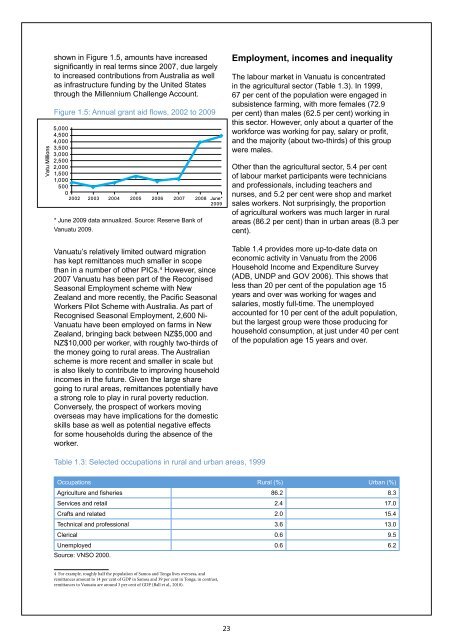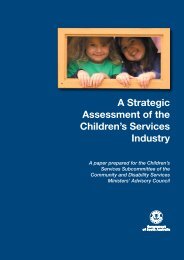Global Study On Child Poverty And Disparities (PDF) - Social Policy ...
Global Study On Child Poverty And Disparities (PDF) - Social Policy ...
Global Study On Child Poverty And Disparities (PDF) - Social Policy ...
Create successful ePaper yourself
Turn your PDF publications into a flip-book with our unique Google optimized e-Paper software.
Vatu Millions<br />
shown in Figure 1.5, amounts have increased<br />
significantly in real terms since 2007, due largely<br />
to increased contributions from Australia as well<br />
as infrastructure funding by the United States<br />
through the Millennium Challenge Account.<br />
Figure 1.5: Annual grant aid flows, 2002 to 2009<br />
5,000<br />
4,500<br />
4,000<br />
3,500<br />
3,000<br />
2,500<br />
2,000<br />
1,500<br />
1,000<br />
500<br />
0<br />
2002 2003 2004 2005 2006 2007 2008 June*<br />
2009<br />
* June 2009 data annualized. Source: Reserve Bank of<br />
Vanuatu 2009.<br />
Vanuatu’s relatively limited outward migration<br />
has kept remittances much smaller in scope<br />
than in a number of other PICs. 4 However, since<br />
2007 Vanuatu has been part of the Recognised<br />
Seasonal Employment scheme with New<br />
Zealand and more recently, the Pacific Seasonal<br />
Workers Pilot Scheme with Australia. As part of<br />
Recognised Seasonal Employment, 2,600 Ni-<br />
Vanuatu have been employed on farms in New<br />
Zealand, bringing back between NZ$5,000 and<br />
NZ$10,000 per worker, with roughly two-thirds of<br />
the money going to rural areas. The Australian<br />
scheme is more recent and smaller in scale but<br />
is also likely to contribute to improving household<br />
incomes in the future. Given the large share<br />
going to rural areas, remittances potentially have<br />
a strong role to play in rural poverty reduction.<br />
Conversely, the prospect of workers moving<br />
overseas may have implications for the domestic<br />
skills base as well as potential negative effects<br />
for some households during the absence of the<br />
worker.<br />
Employment, incomes and inequality<br />
The labour market in Vanuatu is concentrated<br />
in the agricultural sector (Table 1.3). In 1999,<br />
67 per cent of the population were engaged in<br />
subsistence farming, with more females (72.9<br />
per cent) than males (62.5 per cent) working in<br />
this sector. However, only about a quarter of the<br />
workforce was working for pay, salary or profit,<br />
and the majority (about two-thirds) of this group<br />
were males.<br />
Other than the agricultural sector, 5.4 per cent<br />
of labour market participants were technicians<br />
and professionals, including teachers and<br />
nurses, and 5.2 per cent were shop and market<br />
sales workers. Not surprisingly, the proportion<br />
of agricultural workers was much larger in rural<br />
areas (86.2 per cent) than in urban areas (8.3 per<br />
cent).<br />
Table 1.4 provides more up-to-date data on<br />
economic activity in Vanuatu from the 2006<br />
Household Income and Expenditure Survey<br />
(ADB, UNDP and GOV 2006). This shows that<br />
less than 20 per cent of the population age 15<br />
years and over was working for wages and<br />
salaries, mostly full-time. The unemployed<br />
accounted for 10 per cent of the adult population,<br />
but the largest group were those producing for<br />
household consumption, at just under 40 per cent<br />
of the population age 15 years and over.<br />
Table 1.3: Selected occupations in rural and urban areas, 1999<br />
Occupations Rural (%) Urban (%)<br />
Agriculture and fisheries 86.2 8.3<br />
Services and retail 2.4 17.0<br />
Crafts and related 2.0 15.4<br />
Technical and professional 3.6 13.0<br />
Clerical 0.6 9.5<br />
Unemployed 0.6 6.2<br />
Source: VNSO 2000.<br />
4 For example, roughly half the population of Samoa and Tonga lives overseas, and<br />
remittances amount to 14 per cent of GDP in Samoa and 39 per cent in Tonga; in contrast,<br />
remittances to Vanuatu are around 3 per cent of GDP (Ball et al., 2010).<br />
23
















